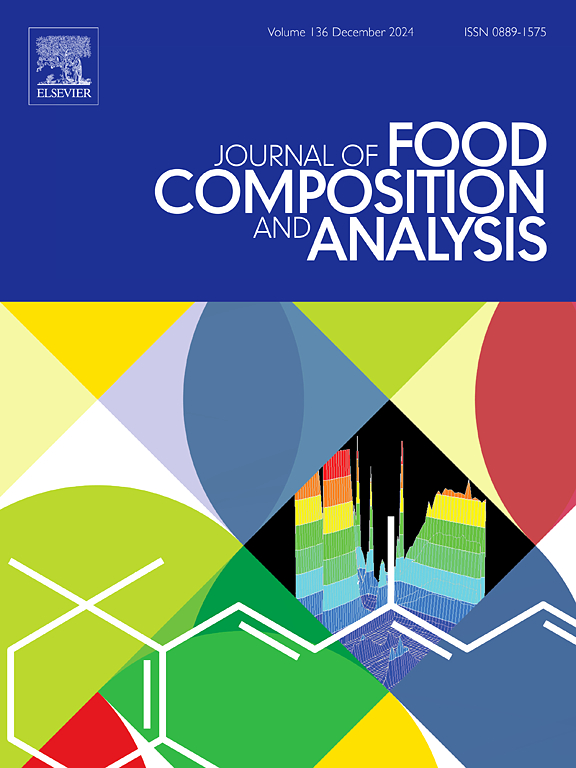Non-destructive origin tracing and ginsenoside quantification in American ginseng using hyperspectral imaging and mixed multi-task 1DCNN
IF 4.6
2区 农林科学
Q2 CHEMISTRY, APPLIED
引用次数: 0
Abstract
Accurate origin tracing and ginsenoside quantification in American ginseng (Panax quinquefolius L.), are critical for its market value and therapeutic efficacy. Empirical identification and chemical analysis methods are often destructive and inefficient. This study addresses these limitations by integrating hyperspectral imaging (HSI) with a novel mixed multi-task one-dimensional convolutional neural network (MMT1DCNN) for the non-destructive and rapid evaluation of ginsenoside content and origin of American ginseng. Adaptive threshold segmentation and spectra extraction are conducted on the raw HSI images to obtain the spectral data of each American ginseng. Four common pretreatment methods are employed to clean and normalize the spectra. The successive projections algorithm is applied to select key bands from spectra, which are then fed into the MMT1DCNN to simultaneously predict the origin and ginsenoside content. A dataset containing spectral, origin, and ginsenoside data of American ginseng is constructed to validate the method's performance. Experimental results demonstrate that the proposed method achieves 95 % overall accuracy for origin classification, a correlation coefficient of 0.965, a root mean square error of 3.64 mg/g, and a residual predictive deviation of 3.54 for ginsenoside content. These findings suggest that the developed method has significant potential for non-destructive, accurate origin tracing and quantitative evaluation of American ginseng.
利用高光谱成像和混合多任务1DCNN对西洋参中人参皂苷进行无损溯源和定量分析
准确溯源和定量分析西洋参中人参皂苷的含量,对西洋参的市场价值和疗效至关重要。经验鉴定和化学分析方法往往是破坏性和低效的。本研究通过将高光谱成像(HSI)与一种新型的混合多任务一维卷积神经网络(MMT1DCNN)相结合,对西洋参中人参皂苷含量和产地进行无损快速评价,从而解决了这些局限性。对原始HSI图像进行自适应阈值分割和光谱提取,得到各西洋参的光谱数据。采用四种常用的预处理方法对光谱进行清洗和归一化。采用连续投影算法从光谱中选择关键波段,然后将其输入MMT1DCNN,同时预测产地和人参皂苷含量。建立了包含西洋参光谱、产地和人参皂苷数据的数据集,验证了该方法的性能。实验结果表明,该方法对人参皂苷的产地分类总体准确率为95 %,相关系数为0.965,均方根误差为3.64 mg/g,剩余预测偏差为3.54。该方法对西洋参的无损、准确溯源和定量评价具有重要的应用价值。
本文章由计算机程序翻译,如有差异,请以英文原文为准。
求助全文
约1分钟内获得全文
求助全文
来源期刊

Journal of Food Composition and Analysis
工程技术-食品科技
CiteScore
6.20
自引率
11.60%
发文量
601
审稿时长
53 days
期刊介绍:
The Journal of Food Composition and Analysis publishes manuscripts on scientific aspects of data on the chemical composition of human foods, with particular emphasis on actual data on composition of foods; analytical methods; studies on the manipulation, storage, distribution and use of food composition data; and studies on the statistics, use and distribution of such data and data systems. The Journal''s basis is nutrient composition, with increasing emphasis on bioactive non-nutrient and anti-nutrient components. Papers must provide sufficient description of the food samples, analytical methods, quality control procedures and statistical treatments of the data to permit the end users of the food composition data to evaluate the appropriateness of such data in their projects.
The Journal does not publish papers on: microbiological compounds; sensory quality; aromatics/volatiles in food and wine; essential oils; organoleptic characteristics of food; physical properties; or clinical papers and pharmacology-related papers.
 求助内容:
求助内容: 应助结果提醒方式:
应助结果提醒方式:


